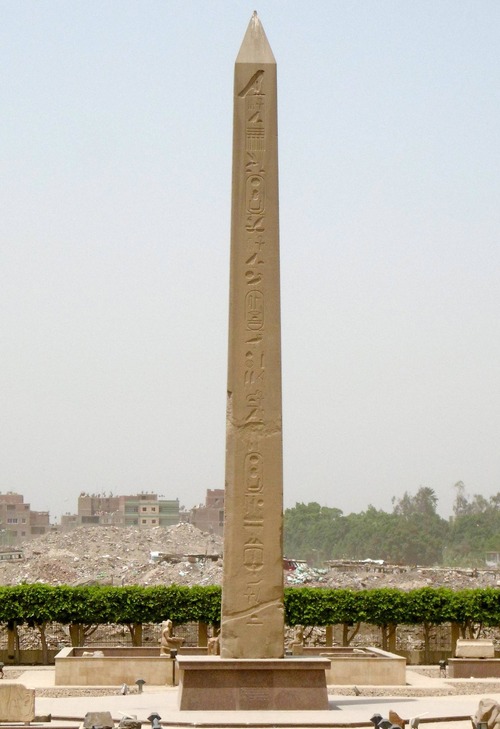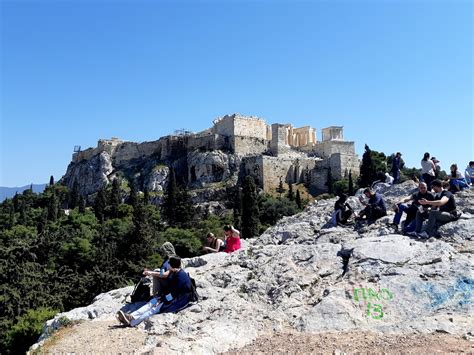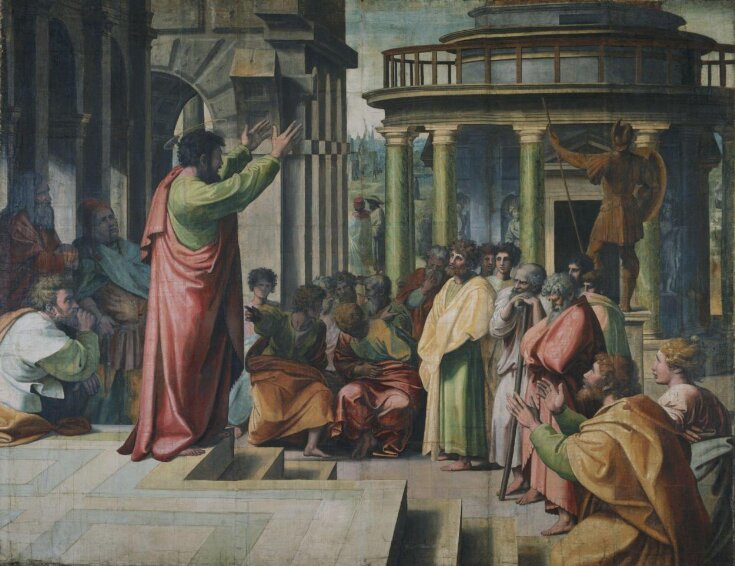The Life of Saint Dionysius the Areopagite

Table of Contents
- Biblical Foundation
- Early Life and Education
- Conversion and Ministry
- Written Works
- Martyrdom and Commemoration
- Historical Sources
Biblical Foundation
The foundational account of Saint Dionysius appears in Acts 17:34: "Howbeit certain men clave unto him, and believed: among the which was Dionysius the Areopagite, and a woman named Damaris, and others with them."1 As the constitution of the Court of the Areopagus required its members to have filled a high magisterial function, such as that of Archon, and to be above sixty, the convert must have been a man of some note.2
According to Dionysius of Corinth (as recorded by Eusebius in Church History III.4), Dionysius the Areopagite was Bishop of Athens.3 Eusebius states: "Besides these, that Areopagite, named Dionysius, who was the first to believe after Paul's address to the Athenians in the Areopagus (as recorded by Luke in the Acts) is mentioned by another Dionysius, an ancient writer and pastor of the parish in Corinth, as the first bishop of the church at Athens."4
Early Life and Education
Saint Dionysius lived originally in the city of Athens. He was raised there and received a classical Greek education. He then went to Egypt, where he studied astronomy at the city of Heliopolis.5 Suidas gives a fuller account, according to which Dionysius was born in Athens, studied there and in Egypt, and became eminent for learning.6

The Eclipse Premonition
It was in Heliopolis, along with his friend Apollophanes where he witnessed the solar eclipse that occurred at the moment of the death of the Lord Jesus Christ by Crucifixion. "Either the Creator of all the world now suffers, or this visible world is coming to an end," Dionysius said.5
Position in Athens
Upon his return to Athens from Egypt, he was chosen to be a member of the Areopagus Council (Athenian high court).5 On account of the wisdom and virtue pagan learning afforded him, he was chosen one of the nine archontes or leaders of the city of Athens, a counselor, as some say, if not the Head of the Athenian senate.7

Conversion and Ministry
Encounter with Saint Paul
As such, it was he who invited the great Apostle Paul, whom the Holy Spirit had brought to the city, to proclaim the good tidings of Salvation on the Areopagus.7 When the holy Apostle Paul preached at the place on the Hill of Ares (Acts 17:16-34), Dionysius accepted his salvific proclamation and became a Christian.5
When Saint Paul spoke of the Saviour's Passion and of the portents that occurred at his death, Dionysius recalled the solar eclipse, inexplicable to astronomers, that had happened years before when he was in Egypt completing his studies among learned men at Heliopolis. 'Either God is suffering', he had cried out then, 'or this is the end of the world!' This event prepared Dionysius and his master Hierotheus to recognize Him who overcomes the laws of nature when He so wills; so they listened eagerly to the holy Apostle's teaching and asked him for Baptism.7

Apostolic Formation and Episcopal Ministry
For three years Saint Dionysius remained a companion of the holy Apostle Paul in preaching the Word of God.5 From here he is believed to have travelled with St. Paul learning about the faith for around three years before he returned to Athens and was enthroned as its Bishop.8
After some time, Saint Paul departed to endure new tribulations, and left Saint Hierotheus as Bishop of Athens. Like the eagle that can look directly upon the brightness of the sun, Hierotheus was able to enter into the mysteries of God. But he wrote little, choosing rather to instruct his disciple Dionysius orally concerning the revelations beyond all speech that God granted him. On Hierotheus' death, Dionysius became Bishop of Athens in his stead.7
Later on, the Apostle Paul selected him as bishop of the city of Athens.5 Regarding St. Dionysius' Episcopacy, there is little known, though we are told by Eusebius that he was the first Bishop of Athens.3
Mystical Experiences and Missionary Work
Saint Dionysius attained such heights of divine contemplation that he was accounted worthy of being numbered among the Apostles, and was wondrously transported to Jerusalem for the entombment of the Mother of God. His greatest journey in his Episcopacy is, however, to Jerusalem, where it is said that he visited St. Mary and was present at her dormition. He made a number of journeys outside Greece and was present when the Apostles were assembled at the Dormition and glorious Assumption of the Mother of God. He wrote of Her, and he became a friend of Saint John, Her guardian.
We also know from tradition that he travelled often in missions to the West and established a reputation for his work in Germania and Gaul, bringing many to the faith. Towards the end of Nero's reign, he visited Rome to give his master, Saint Paul, an account of his missionary activity. He was present at Paul's martyrdom and then returned to Greece.
On a later visit to Rome, Saint Dionysius and his disciples, the priest Rusticus and the deacon Eleutherius, were commissioned by Saint Clement, the Bishop of Rome, to preach the Gospel in Gaul. He left Saint Publius as his successor in Athens, and departed for Rome with Eleutherius and Rusticus. Pope Saint Clement of Rome confirmed this enterprise, and added to the group at least ten more priests, all of whom are now listed among the Saints. When he had preached the word of truth in a good many places, Dionysius settled in Paris, which was then a small town sunk in the darkness of ignorance and paganism.7
Written Works
God enabled him by His grace to put into writing the sublime teachings of his masters about the unutterable boundlessness of the divine Nature (to which none but the negative terms of apophatic theology are applicable) and about the unfathomable riches of His revelation through His Names and Energies that is the sum of affirmative theology. He described how the sensible world (that perceived by our senses) and the intelligible world (that apprehended by the illumined intellect) are united to God in a magnificently ordered hierarchy.7
The writings of Saint Dionysius the Areopagite hold great significance for the Orthodox Church. Four books of his have survived to the present day:5
Extant Works
- On the Divine Names (Περὶ θείων ὀνομάτων)
- On the Celestial Hierarchies (Περὶ οὐρανίας ἱεραρχίας)
- On the Ecclesiastical Hierarchies (Περὶ ἐκκλησιαστικῆς ἱεραρχίας)
- On Mystical Theology (Περὶ μυστικῆς θεολογίας)
- Ten Epistles to various correspondents
Lost Works
Saint Dionysius frequently references seven other theological treatises in his surviving works, which are presumed to have been lost over the centuries. These works, mentioned throughout the corpus, include Theological Outlines (Θεολογικαὶ ὑποτυπώσεις), which apparently contained fundamental theological principles; Symbolic Theology (Συμβολικὴ θεολογία), dealing with scriptural symbols and their mystical interpretation; On Angelic Properties and Orders (Περὶ ἀγγελικῶν ἰδιοτήτων καὶ τάξεων), providing detailed exposition of the angelic hierarchy; On the Just and Divine Judgement (Περὶ δικαίου καὶ θείου δικαστηρίου), addressing divine justice; On the Soul (Περὶ ψυχῆς), exploring the nature of the human soul; On Resurrection (Περὶ ἀναστάσεως), concerning the resurrection of the dead; and On the Divine Hymns (Περὶ θείων ὕμνων), interpreting liturgical and scriptural songs. The frequent citations of these works in the surviving corpus suggest they formed part of a comprehensive theological system covering the full range of Christian doctrine and mystical experience.
The written works of Saint Dionysius the Areopagite are of extraordinary significance in the theology of the Orthodox Church, and also for late Medieval Western theology. For almost four centuries, until the beginning of the sixth century, the works of this holy Father of the Church were preserved in an obscure manuscript tradition, primarily by theologians of the Alexandrian Church. The concepts in these works were known and utilized by Clement of Alexandria, Origen, Dionysius the Great, pre-eminent figures of the catechetical school in Alexandria, and also by Saint Gregory the Theologian.5
Martyrdom and Commemoration
According to one tradition, he was killed at Lutetia (ancient name of Paris, France) in the year 96 during the persecution under the Roman emperor Dometian (81-96). Today most scholars and theologians believe that Saint Dionysius the Areopagite did not die in Gaul, and that Saint Dionysius (or Denys) of Paris is a different saint with the same name. Saint Demetrius of Rostov says that the Hieromartyr Dionysius was beheaded in Athens, and that many miracles were worked at his grave.5
His memory is celebrated on October 3. He is venerated as a saint in the Catholic and the Eastern Orthodox churches. He is the patron saint of Athens and is venerated as the protector of judges and the judiciary.9
Historical Sources
Primary Historical Testimony
Eusebius of Caesarea (Church History III.4) records the testimony of Dionysius of Corinth that Dionysius the Areopagite became the first Bishop of Athens.
Suidas (Byzantine Lexicon, 10th century) provides biographical details including his studies in Athens and Egypt, his witness of the eclipse at Heliopolis, and his conversion through Saint Paul's preaching.
Medieval Hagiographical Sources
Michael Syncellus (9th-century monk) wrote an authoritative biography translated for the first time in English, presenting him as an inspired prophet, merciful pastor, and zealous missionary.
Hilduin of Saint-Denis (c. 785-c. 860), abbot of Saint-Denis in Paris and archchaplain to Louis the Pious, compiled hagiographical material in 835 at the commission of Emperor Louis, identifying Dionysius of Paris with the Areopagite.
Orthodox Tradition
From the Synaxarion of the Orthodox Church "The purpose of hagiography is the reduction, from the perceivable to the imaginable, from the material to the spiritual and from the ephemeral to the eternal. Through hagiography all is depicted not as a sight but as a mystery." Fotis Kontoglou
This compilation draws from traditional Orthodox hagiographic sources, the testimonies of Church Fathers, and historical accounts that affirm the apostolic identity of Saint Dionysius the Areopagite as the same person mentioned in Acts 17:34.
Bibliography
Eusebius of Caesarea. Ecclesiastical History. Translated by Philip Schaff. In Nicene and Post-Nicene Fathers, Second Series, Vol. 1. New York: Christian Literature Publishing Co., 1890.
"Hieromartyr Dionysius the Areopagite, Bishop of Athens." Orthodox Church in America. Accessed August 9, 2025. https://www.oca.org/saints/lives/0201/10/03/102843-hieromartyr-dionysius-the-areopagite-bishop-of-athens.
Hilduin of Saint-Denis. Passio S. Dionysii. In Michael Lapidge, ed., Hilduin of Saint-Denis: The Passio S. Dionysii in Prose and Verse. Leiden: Brill, 2018.
Lapidge, Michael. "Hilduin of Saint-Denis." Wikipedia, November 9, 2024. https://en.wikipedia.org/wiki/Hilduin_of_Saint-Denis.
"Saint Dionysius the Areopagite, First Bishop of Athens and of Paris and his Companions, Martyrs." Sanctoral. Accessed August 9, 2025. https://sanctoral.com/en/saints/saint_dionysius_the_areopagite.html.
Scriptorium Press. The Life of Saint Dionysius the Areopagite. Translated from Michael Syncellus. Scriptorium Press, 2023.
"St. Dionysius The Areopagite." Urho, The Way. November 20, 2020. https://urhotheway.com/2020/11/20/st-dionysius-the-areopagite/.
Suidas. Suda. Byzantine Lexicon, 10th century.
Wikipedia Contributors. "Dionysius the Areopagite." Wikipedia, August 4, 2025. https://en.wikipedia.org/wiki/Dionysius_the_Areopagite.
-
Acts 17:34 (King James Version). ↩︎
-
Acts 17:34 Commentaries, Bible Hub, accessed August 9, 2025, https://biblehub.com/commentaries/acts/17-34.htm. ↩︎
-
Eusebius of Caesarea, Ecclesiastical History, III.4.11, trans. Philip Schaff, in Nicene and Post-Nicene Fathers, Second Series, Vol. 1 (New York: Christian Literature Publishing Co., 1890). ↩︎
-
"Hieromartyr Dionysius the Areopagite, Bishop of Athens," Orthodox Church in America, accessed August 9, 2025, https://www.oca.org/saints/lives/0201/10/03/102843-hieromartyr-dionysius-the-areopagite-bishop-of-athens. ↩︎ ↩︎ ↩︎ ↩︎ ↩︎ ↩︎ ↩︎ ↩︎ ↩︎
-
Suidas, Suda, s.v. "Dionysius," cited in "Dionysius the Areopagite," Encyclopedic Dictionary of Bible and Theology, accessed August 9, 2025, https://www.biblia.work/dictionaries/dionysius-the-areopagite/. ↩︎
-
"Saint Dionysius the Areopagite, First Bishop of Athens and of Paris and his Companions, Martyrs," Sanctoral, accessed August 9, 2025, https://sanctoral.com/en/saints/saint_dionysius_the_areopagite.html. ↩︎ ↩︎ ↩︎ ↩︎ ↩︎ ↩︎
-
"St. Dionysius The Areopagite," Urho, The Way, November 20, 2020, https://urhotheway.com/2020/11/20/st-dionysius-the-areopagite/. ↩︎
-
"Dionysius the Areopagite," Wikipedia, August 4, 2025, https://en.wikipedia.org/wiki/Dionysius_the_Areopagite. ↩︎